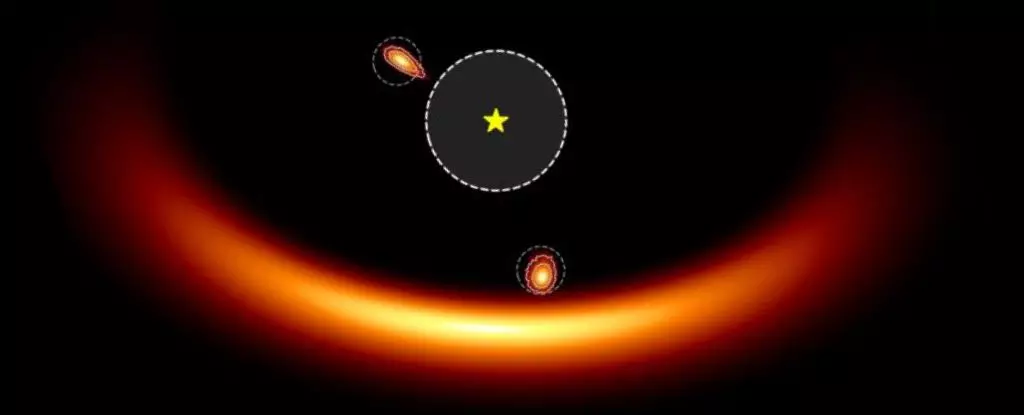The formation of planets is a profound and intricate process occurring within swirling disks of gas and dust that envelop young stars. This primordial dance of matter not only forms planets but also tells us about the early stages of planetary systems, including our own. Among the stars and their surrounding materials, astronomers have turned their gaze toward a remarkable system known as PDS 70, which has garnered substantial interest due to the ongoing formation of at least two planets. The study of PDS 70 stands as one of the prominent objectives of the James Webb Space Telescope (JWST), providing crucial insights into the complexities of planet formation.
Located approximately 370 light-years away in the constellation Centaurus, PDS 70 is classified as an orange dwarf star. Around this star, two planets, designated PDS 70b and PDS 70c, are in various stages of formation. The significance of these planets transcends their existence; PDS 70b holds the landmark title of being the first protoplanet ever directly imaged. This groundbreaking detection was achieved using the European Southern Observatory’s Very Large Telescope (VLT) in 2018, employing an innovative instrument known as SPHERE, which provided unprecedented views of the planets and their characteristics.
Research on the atmosphere, mass, and temperature of both planets has expanded significantly since their initial discovery, thanks to additional observations. However, the JWST has pushed the boundaries further by enabling astronomers to revisit the PDS 70 system with advanced tools and techniques, shedding light on previously obscured aspects of this intriguing cosmic environment.
A recent study led by Dori Blakely, a graduate student at the University of Victoria in Canada, employed the JWST’s Near Infrared Imager and Slitless Spectrograph (NIRISS). Utilizing a feature known as Aperture Masking Interferometry (AMI), the telescope enabled astronomers to achieve a significantly higher resolution than what previously recorded observations allowed. By mimicking the effects of a larger telescope through the use of a specialized mask, JWST made groundbreaking interferometric observations of PDS 70 for the first time.
These new observations revealed intriguing evidence of surrounding material around both PDS 70b and PDS 70c, reinforcing theories regarding their ongoing formation. As lead author Blakely described the findings, it is akin to capturing a snapshot of our own Solar System during its formative years—an opportunity to understand planetary genesis on a fundamental level. Such insights are vital as they tackle significant questions about how planetary systems emerge and evolve over time.
New Findings and the Quest for a Third Planet
Prior to this groundbreaking research, observations of the PDS 70 planets primarily employed shorter wavelengths, often interpreted through models designed for low-mass stars and brown dwarfs. Notably, the JWST’s longer wavelength observations unveiled more light than previous methodologies could detect, leading to the hypothesis of warmer material surrounding both young planets. This material is believed to be accumulating from a circumplanetary disk—a vital aspect of planetary growth.
In an exciting twist, the research introduces the suggestion of a potential third planet within the PDS 70 system, informally referred to as PDS 70d. Initial hints of this new planet appeared in a 2024 study; however, uncertainty surrounded its nature, leading to speculation that the detected signals could indeed stem from a dust clump or material spiral. Remarkably, the recent JWST observations provided further constraints on the characteristics of this mysterious object, regardless of its true identity.
The Significance of Ongoing Observations
The findings spur enthusiasm for continued research into the PDS 70 system, with scientists eager to unravel the complexities of its components. Each observation provides vital data that can help delineate the atmospheric compositions of the planets and their potential differences. If PDS 70d does indeed exist, it may be significantly distinct from its counterparts PDS 70b and PDS 70c.
As co-author Doug Johnstone aptly stated, these observations present a unique opportunity to witness the intricate processes of planet formation in real-time. Engaging with these celestial phenomena not only enriches our understanding of PDS 70 but also elucidates broader questions of planetary science, shedding light on the dynamic lifecycle of star systems across the universe.
The PDS 70 system serves as a tantalizing laboratory for scientists exploring the foundations of planetary formation. With the utilization of cutting-edge technology from the JWST, researchers are taking significant strides in understanding how cosmic materials coalesce to form planets. As we witness the unfolding narrative of PDS 70, we glean insights not just about this distant system, but also about the origins of our own Solar System and the myriad worlds beyond. The journey of exploration is just beginning, promising even more revelations about planetary environments that shape the cosmos.


Leave a Reply